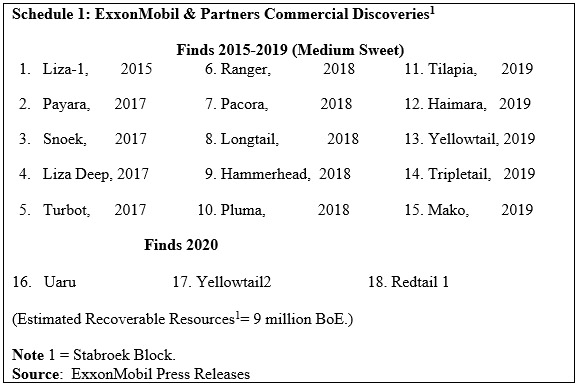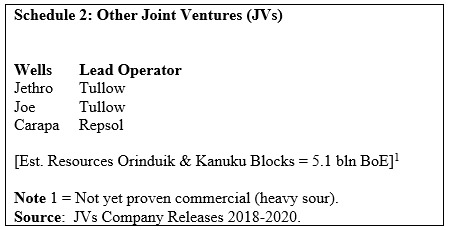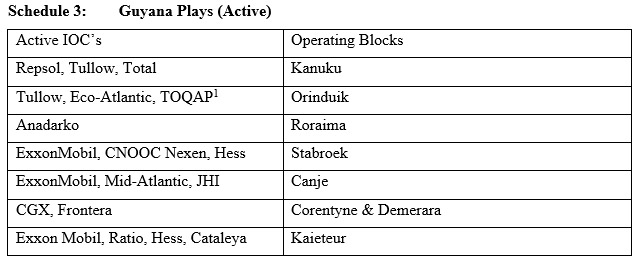Introduction
Last week’s column explained the enigma of, on the one hand, repeated striking downward revisions to Guyana’s expected real GDP growth for 2020 (initially set at 85% by the IMF and Government of Guyana, GoG in Q4, 2019). And, on the other, ending the year, with measured rates of 8.1 percent (IMF) and 45.1 percent (GoG). These later rates are still among the highest globally, and doubly significant in a year when only a handful of countries enjoyed positive growth! The explanation for this enigma, I believe, lies in the world class of Guyana discoveries. As, a result, one notes also that, despite the major setbacks endured in 2020, the ExxonMobil and partners’ industry target of 750,000 barrels of crude oil per day is expected to be achieved comfortably. The same explanation applies.
As a consequence, today’s column offers a summary recap of why Guyana’s finds are of world class petroleum potential.
World Class Potential
Up to date, reported estimates of Guyana’s recoverable oil and gas resources operated on by ExxonMobil and partners stands at approximately 9 billion barrels of oil equivalent (BoE). There were 18 discoveries as listed in Schedule 1, which follows:
In addition, two other joint venture groupings (JVs), namely 1) Tullow, lead Operator, Total and Eco-Atlantic and 2) Repsol, lead Operator, Tullow and Total, have announced three prospective finds in 2020, based on commissioned Prospective Resource Estimates totaling about 6 billion BoE for their best estimate. These finds were found in the Jethro 1 and Joe 1 wells for the first JV, and the Carapa well for the second JV. These estimates are provided in updated commissioned studies. These data are reproduced in Schedule 2 below. Note, these finds are located outside the Stabroek Block, in the Orinduik and Kanuku blocks.
Further to this, two months ago, CGX Energy and Frontera Energy, another JV, announced a Competent Persons Report on prospective resources of 4.84 billion BOE, best estimate. This was produced by Mc Daniel and Associates Consultants Ltd. The finds were also located outside the Stabroek block. This time in the Corentyne and Demerara blocks. Details indicate most of the prospective resources are located in the Corentyne block and only 525 million barrels in the Demerara block. The JV hopes to drill 32 prospects this year, 27 in Corentyne and five in Demerara, with CGX the Operator
Companies and blocks
To date, there are 15 reported international oil companies operating in Guyana; namely, ExxonMobil, CNOOC Nexen, Hess operating in Stabroek block; Repsol, Tullow, Total operating in Kanuku block; Anadarko operating in Roraima block; CGX, Frontera operating in Corentyne and Demerara block; Tullow, Total, Eco- Atlantic operating in Orinduik block; ExxonMobil, Ratio, Hess, Cataleya operating in Kaieteur block, ExxonMobil, Mid- Atlantic, JHI operating in Canje block. There are 8 blocks in play. These data are summarized in Schedule 3 below
Note: 1 = Total & Qatar Petroleum
Source: Author’s Construct
It is apt to note that when Exxon and partners had reported its first discovery back in 2016, it was only for an amount which was less than one billion barrels of oil equivalent, BoE. In the face of this, I had boldly predicted that Guyana’s discoveries would eventually reach at least 13 to 15 billion BoE. That prediction was not a hunch, nor was it based on “guesswork”, “gut feelings”, or indeed “intuition”. In truth, it was based on two lines of reasoning, which flowed from my desk research into Guyana’s energy potential during 2015. The first of these was termed the “Atlantic mirror image” geological principle. And, the second was based on United States Geological Service, USGS, Fact Sheets, released in 2000 and 2012.
As regards the latter, I hasten to remind readers that previously I had indicated the USGS Survey assessments had been conducted as a subset of the USGS’ World Assessments. Further, the natural gas estimates are reported in cubic feet and natural gas liquids in BoE. The standard conversion ratio of natural gas to BoE is 6,000 cubic feet of natural gas is equivalent to one BoE.
Conclusion
Next week’s column will summarily recap the details that lead to the reasoning, which underpins my persistently bullish outlook on Guyana’s oil and gas resource potential













